It is unusual to see a Nigerian name on an exhibition poster at Park Oliwski, a 500-year-old garden in Gdansk, a city in the north of Poland. This is where the modern collections of the country’s National Museum are held, in the Abbots’ Granary – a palace built in Rococo style – located between a catholic cathedral and watermills that date back to the year 1652.
For the first time in its 70-year history the Department of Modern Art has decided, thanks to effort from curator Małgorzata Paszylka-Glaza1, to show contemporary artworks from Africa. Up until now the only artworks from the continent were in the collection of the Ethnographic Department, comprised mostly of ceramics and jewellery. In this exhibition artist Bob-Nosa Uwagboe’s work of 30 mixed-media works on canvas and 59 drawings occupies all three rooms of the museum.
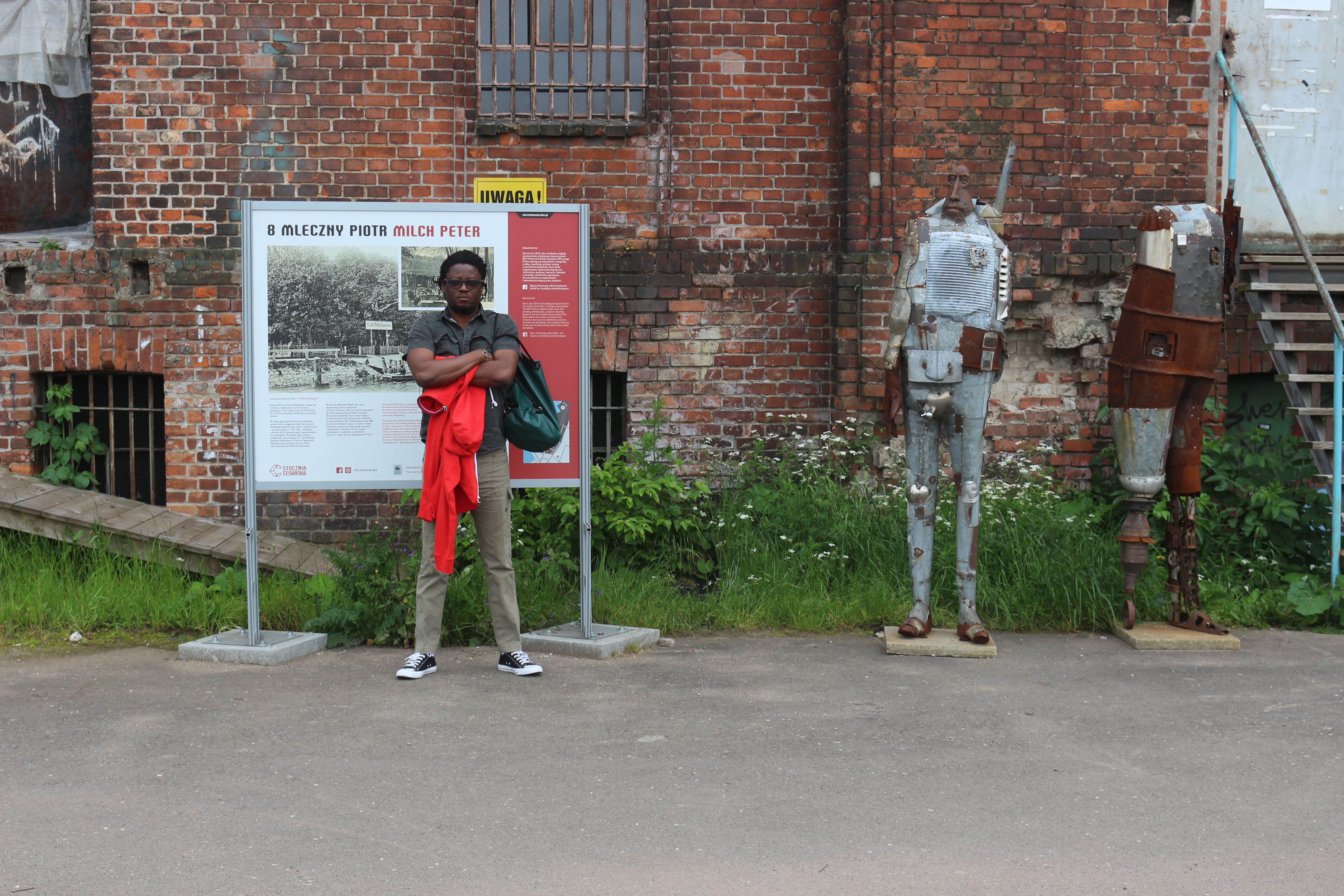
Though the exhibition was announced months ago, visitors had to wait a further seven weeks before public and private institutions could reopen, a result of the COVID-19 pandemic. This was a time that intensified the processes of the late Anthropocene human experience and exposed the failings of the discriminative and abusive global capitalist-driven socio-political and economic systems .
On entering the elegant hall of the museum, my senses were sharp and my heart longing for some real-time interaction with art. Transit appears as notes from the Old World, snapshots from a wild and brutal pre-funeral party where, Uwagboe says, the invisible “society of Black”2 are invited. It is particularly moving to experience this exhibition in the wake of “an undead organism indifferent to its host’s age, sexual orientation, class, and/or race” terrorising human populations across the world.
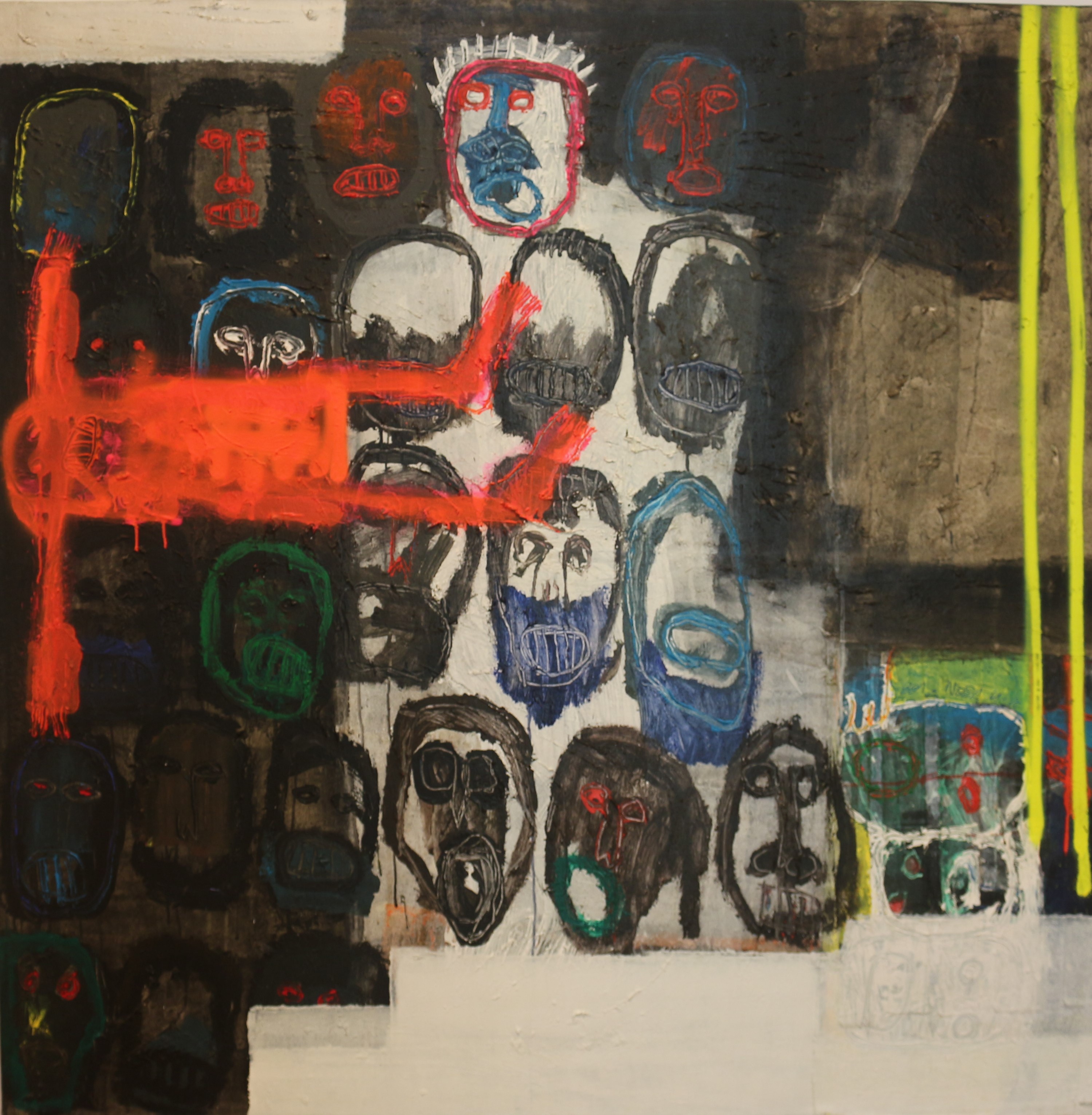
Just like the heroes of his paintings, simply being there for us to see and acknowledge them. Praise them. Remember them. Fight for them…
The paintings are expressive, direct and smashing. With hysterical colours and brutal strokes, they scream out about injustice, systemic violence, individual and collective stories of pain, hate, rage, hopelessness and oppression.
These horror stories are not coming from Hollywood or Nollywood; they are coming from the streets. They are real stories from refugee camps, from the rafts, slums, prison cells in Nigeria, Libya, Morocco. These powerful images stick to the back of your eyelids and remain in your memory. I take a walk around the exhibition to look for some comfort, but the artist offers none.
Uwagboe’s series of grim drawings on watercolour paper consists of 59 images depicting one story. A story of enslavement, but not the story of European ships crossing the Atlantic. This is the recent story of people being kept in cages for “a good price”. These “big strong boys for farm work” are represented here in the Transit exhibition as nameless bodies, meat that is served for the others to feast on. These works have no mercy on the viewer; you have to go through each of them before you can exit the gallery. The works disturb, crushing feelings of security and hope.

So I do what they tell me to do, I start to dig. I educate myself on these stories that are missing from European mainstream and social media bubbles. I attempt to learn and become vulnerable at the same time. All the while I am amazed with the artist’s persistence and strong commitment to the singular theme that occupies his practice; human beings, in all the darkest and least favourable forms of existence.
Rage can also kindle at a painter’s canvas…
Uwagboe says he has stayed true to his core beliefs throughout his professional life. He feels it important to stay close to the streets that become inspiration for his paintings. He built his home and his workspace, the Protest Art Studio, in Lagos; but not in the gated communities or amongst high society, usually connected to the art world. Everyday, he walks along the same streets in the residential area he lives in on the mainland, he supports his local community and is involved in his neighbours lives.
His voice is loud and clear, he is not afraid to address these issues; of violence, rape, poverty, victimisation, to shout for justice, to precisely point out what he wants to say. The public is not asked to interpret here, we are kindly asked to shut up and listen and observe and then, perhaps, act to make things better.
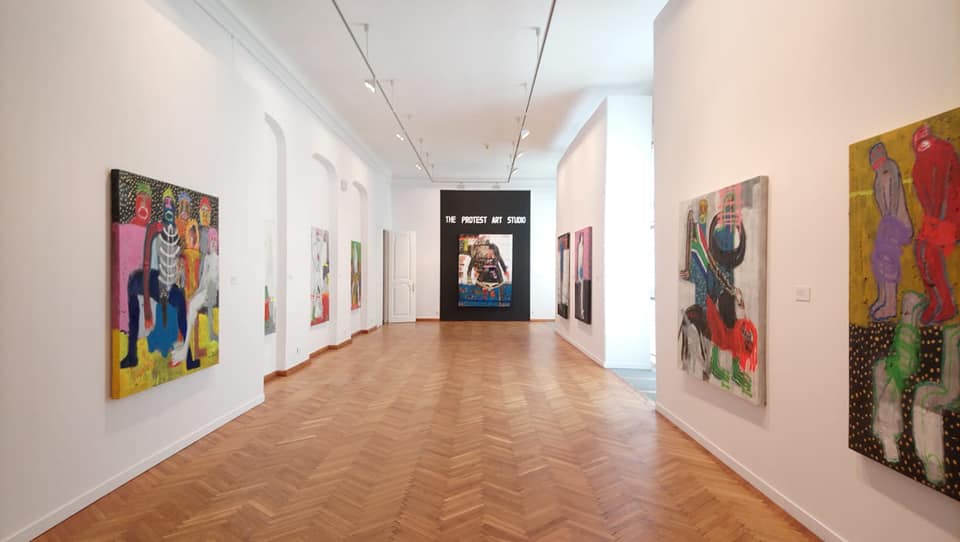
The Transit exhibition feels like a call to remember. To simply keep in mind that the struggle is real, and that no one should suffer this much. It brings to mind the words of the Polish poet Czesław Milosz3:
[…]Someone else will read
of the passing of things human,
of the oblivion
born before the flames have died.
[…]
Those dying here, the lonely
forgotten by the world,
our tongue becomes for them
the language of an ancient planet.
Until, when all is legend
and many years have passed,
on a new Campo dei Fiori
rage will kindle at a poet’s word.
Rage can also kindle at a painter’s canvas as it does in Uwagboe’s smaller exhibition titled R.I.P at the WL4 Mleczny Piotr art space in Gdansk’s historical Shipyard, comprised of works of the same name. Prevented from returning home due to travel restrictions during the COVID-19 lockdowns, the art space became Uwagboe’s temporary studio. In the “R.I.P” series one can contemplate on 15 acrylic paintings on watercolour paper that were made during this time.

As the many conditions of this period were particular and quite different from the usual settings of the artist’s process, these works are quite special. Uwagboe decided to address the current situation of the corona-crisis from a personal perspective. He allowed himself to explore the anxiety and the basic fear of death that became a big part of the everyday emotional experiences.
The drawings are small, simple in form and muted in colour. Like the works in Transit, they appear to pay homage to victims but this time to those who died of COVID-19. However, unlike the works in Transit, these pieces offer a feeling of consolation. For Uwagboe, they are deeply connected to a spiritual understanding of death and acceptance of the passage of time. The work in this series gives some kind of hope. Hope for a new world, for new beginnings, if only we get through those hardest experiences together in peace.
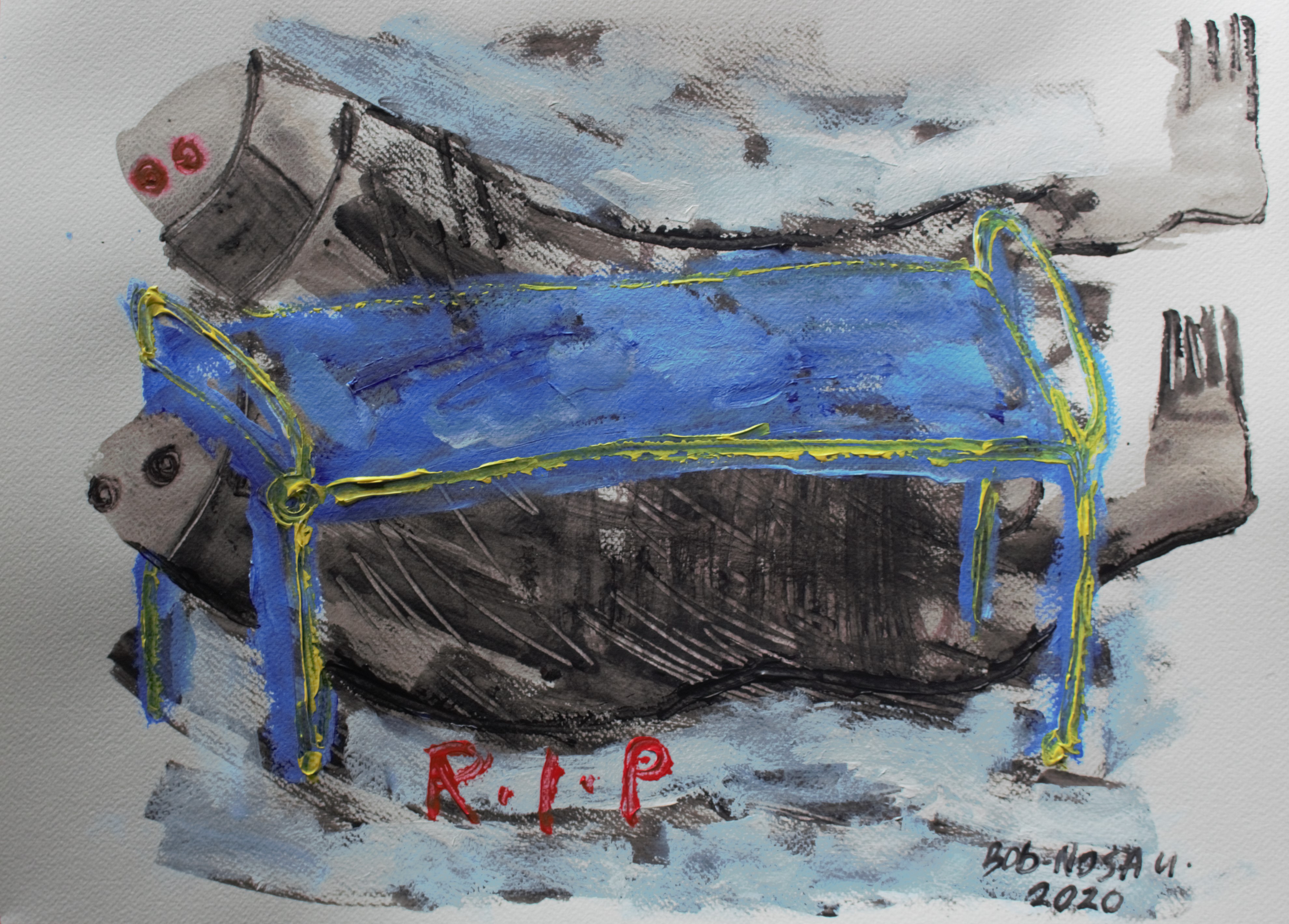
If Transit marks the madness and late-stage Anthropocene decomposition, R.I.P is the quiet presence of a rock that is left after the earthquake. Franz Kafka summed this up best when he wrote: “Everything and everyone that you love, you will eventually lose, but in the end, love will return in a different form.”
It is interesting that the “R.I.P” works came to be in Gdansk Shipyard, a place where many artists have produced works with the theme of death. In Poland, death-related work in art and music is a huge topic and for a Gdansk-based person the parallel is clear. It transports us to the music composed by local artists Nagrobki and Trupa Trupa and the works of a poet and musician Grzegorz Kwiatkowski. In the latter’s poetic worlds there is a conviction that it is impossible to escape from the “dark matter” that surrounds us. From that lining of the world filled with Kurtz’s “horror”. The diagnosis is simple: we are accomplices to our own misfortunes and it suits us4.
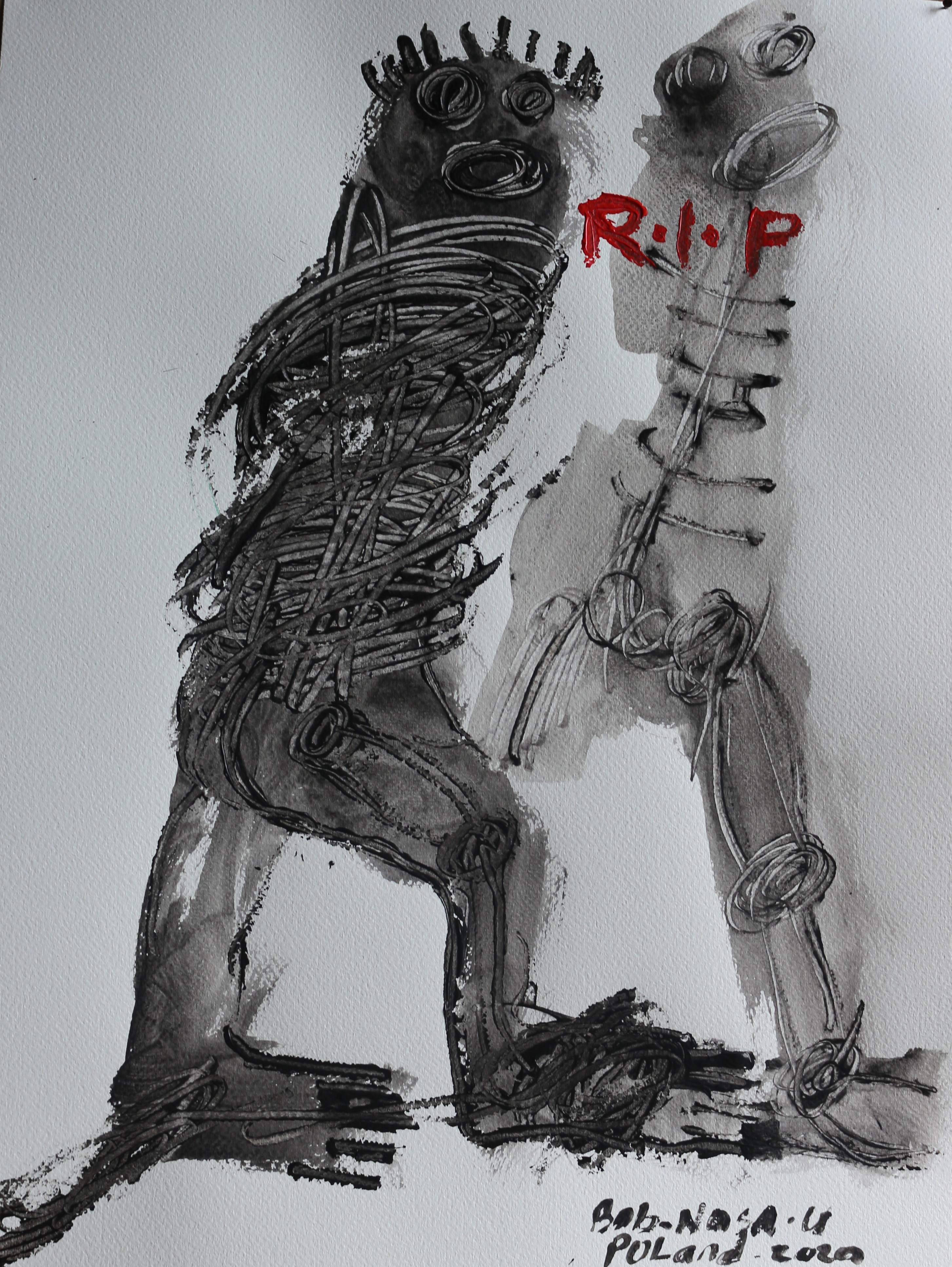
This last thought is even more striking now, while we observe uprisings in the United States and a wave of protests across the world concerning systemic racism and violence, police brutality, social injustice and ruthless colonial legacies. Looking at all that through the Protest Art Studio lens gives me hope that with consciousness, remembrance and spirituality we might have a chance for surviving as a human race.
Now we must fight for the least fortunate, as no one is safe until everyone is safe5. That is for me what is most essential in Uwagboe’s art practice: focusing on human beings. Always being close to the vital energy of life, with all its beauty, rage, monstrosities and sufferings. Uwagboe as an artist has never left neither his ideals nor his Protest studio in order to be accepted by the art world.
Just like the heroes of his paintings, simply being there for us to see and acknowledge them. Praise them. Remember them. Fight for them until times change, until the usurpers step down, until the Earth will be free from the deficient custody of the human race, until we learn to live in peace and respect with each other.
The revolution shall not be televised6. The revolution shall come from the streets, from the hearts and conscious minds, from the merciless viruses uniting societies, from the artists showing us the way. The revolution shall be our last will, otherwise we will perish.
–
Weronika Morawiec, 1985, M.A. in clinical psychology, has been involved with art projects since 2018. In 2019 she participated in the Curatorial Intensive program of the Lagos Biennial. She cooperates with: Goyki3 Art Inkubator, Tunis Central art association and Selma Feriani Gallery.
1 Małgorzata Paszyłka-Glaza: curator of the Modern Art Collection of the Department of Modern Art of the National Museum in Gdańsk. Member of the Association of Art Historians, curator and lecturer at the Gdańsk Higher School of Humanities at the Faculty of Pedagogy, Paszyłka-Glaza is also an author of texts on art. She is also involved with art-therapy sessions for prisoners.
2 I relate to an expression used by Bob-Nosa Uwagboe in one of our conversations; “the invisible Black society”, which includes groups and individuals from various backgrounds in Africa that he says are suffering the most oppression, not only from colonial and capitalistic systems but also from their peers and local communities. These people, he says, are rarely recognised in the global media and/or history. Also mentioned again later in the main text.
3 Campo Dei Fiori, Czesław Milosz’s poem, translated by Louis Irribarne and David Brooks, from Collected Poems (New York: Eco Press, 1973, pp 33-35)
4 Paraphrase of the critical text on Grzegorz Kwiatkowski’s creation, by Paweł Podlipniak
5 Words of Tedros Adhanom Ghebreyesus head of the World Health Organization
6 I paraphrase here a famous line from Gil-Scot Heron’s song and poem “The Revolution Will Not Be Televised”, 1970. During the recent US protest wave ignited with the death of George Floyd this phrase was often called out and reframed.




